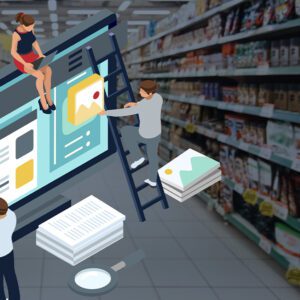Insider Intelligence predicts that mobile commerce sales will account for 43.4% of total U.S. retail ecommerce sales — and 6.5% of all U.S. retail sales — in 2023. Although standard m-commerce sites offer ease and convenience, more consumers are spending more time in mobile apps, especially those that offer seamless and immersive brand experiences.
In fact, a survey of more than 600 consumers found that nearly 90% have at least one mobile shopping app installed on their phone, and half of those users tap into these apps at least a few times a week. Additionally, 31% of consumers, especially those 44 years old and younger, said they prefer shopping in-app to shopping via a mobile or desktop website and even in-store.
To boost app downloads and usage rates, brands need to determine which features and capabilities will help them best differentiate the experience from those of their standard ecommerce and mobile commerce sites. Through an audit of various retail-specific mobile apps across product categories, Retail TouchPoints uncovered five feature categories that support the customer experience:
User Interface and Experience
Mobile app usage may be on the rise, but conversion rates are still a mere 1% to 2%. Many point to user interface and experience as the reason they decide to abandon their mobile carts, and it’s easy to see why: brands and retailers, seeking to differentiate their experience, try to pack their apps with too many bells and whistles. But these features often end up backfiring, ultimately confusing consumers and making the experience feel chaotic and frustrating.
Rent the Runway and StockX both have mobile apps with a simple yet elevated UX that allow their experiences to stand out from standard web counterparts. They are comparable to the ecommerce experience but incorporate features that make shopping more intuitive for mobile consumers; for example, you can easily click and zoom into product imagery, browse through content and narrow searches by category. In a similar vein, Chipotle focuses on the fundamentals of its brand promise, making it easy and straightforward for consumers to build and customize their orders.
Poshmark was also spotlighted for its attention to detail for both buyers and sellers. “Poshmark does an amazing job of connecting everyday sellers with global consumers,” said Angela Gearhart, Executive Consultant at AAG Consulting Group in an interview with Retail TouchPoints. “It’s easy to be a seller, build your closet and directly communicate with your customers, as well as engage on the buyer side with curated content. I love the ease and convenience across the platform and supporting efforts to reuse and recycle.”
Loyalty and Gamification
In the world of retail, loyalty program integration is a table stake for mobile apps. Consumers need to be able to easily log in to their accounts, access rewards and apply their discounts. Retailers like Marks & Spencer have designed their app experiences around their loyalty programs, giving consumers extra reasons to use both in tandem. To further differentiate from the standard ecommerce experience, some brands are integrating gamification into this model.
For example, Starbucks loyalty members who are also app users receive timely notifications about special offers and deals that get them extra perks. Sephora also has a dedicated section of its app, called Beauty Offers, where loyalty program members can see how they can get additional points for specific products. These limited-time offers are the carrots that some consumers need to make a purchase — and in some cases, test new products and brands.
Advertisement
Customer Recognition
Consumers are incredibly attached to their mobile devices, making them their most prized and personal possessions. That is why the smartphone has arguably become the nucleus of the omnichannel customer experience — and why customer recognition and personalization capabilities are central to a differentiated mobile app experience. Being able to access universal product recommendations, shopping lists and carts as consumers jump between mobile and desktop can drive brand engagement and conversions.
The Target app is “king,” according to Melissa Minkow, Director of Retail Strategy for CI&T, because customer recognition “makes shopping much easier.” When app users log in to their accounts, they can access everything they need to have an enriching experience, whether they’re in a store, at home or on the go. “The wallet means I don’t have to bring my Red Card with me, I can add my ‘staples’ easily in case I forgot I needed them, and the documentation of purchases to make returns is so easy,” said Minkow in an interview with Retail TouchPoints.
Other brands bring the value of the mobile app experience to the next level by giving users exclusive access to personalized tools and features. For example, True Religion allows consumers to quickly “swipe” to like and add products to curated wish lists that they can shop later. They also can shop curated looks designed by members of the True Religion team. Crocs’ mobile product try-on tools and a Jibbitz Charms customization tool allow customers to build and buy their creations, which creates a dynamic environment that inspires upsells.
Store Integration and Localization
Because consumers always have their smartphones on them, many retailers are thinking about how they can incorporate exclusive store-related features into their app experiences. For example, the Sephora mobile app has “Store Mode,” which allows users to access tailored information about the physical store they’re in. They can see if their favorite products are in stock, book services and lessons, see exclusive in-store discounts and more.
The Home Depot takes this a step further by incorporating item location into the app experience. “I’ve grown to appreciate the Home Depot app because it does well with the basics of providing different ways to search for products,” said Guy Courtin, VP of Industry and Advanced Technology at Tecsys, Inc. in an interview with Retail TouchPoints. “But what I like is it can tell you the location of an item within a store. I’ve used the app plenty of times when I’m already in a store to find where a product is located, which creates a great tie-in between brick-and-mortar and ecommerce.”
Exclusive Access
If brands want their consumers to frequently open and shop using their mobile apps, they have to create a reason for them to engage. Some companies have doubled down on financial value; for example, Shein gives app users early access to flash sales and exclusive deals. However, other brands are emphasizing social value by using their mobile apps as vehicles for exclusive products and content.
For example, Sephora gives app users access to a unique, app-only product selection, and True Religion provides exclusive access to new product drops and limited collections. The SNKRS app by Nike enhances this model by also incorporating unique content and events, turning the app environment into the ultimate destination for brand and community engagement.
















